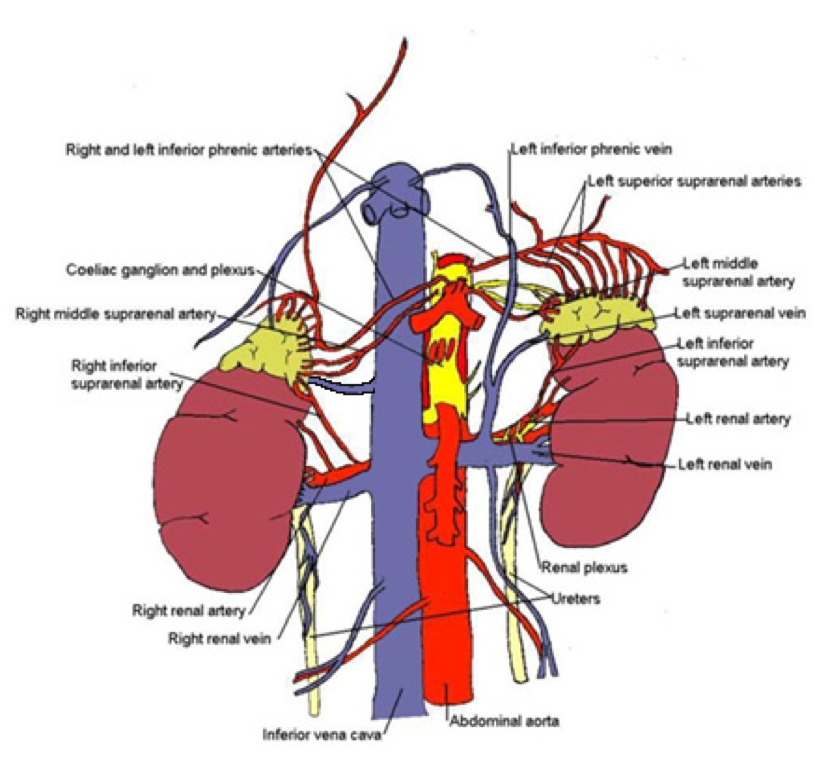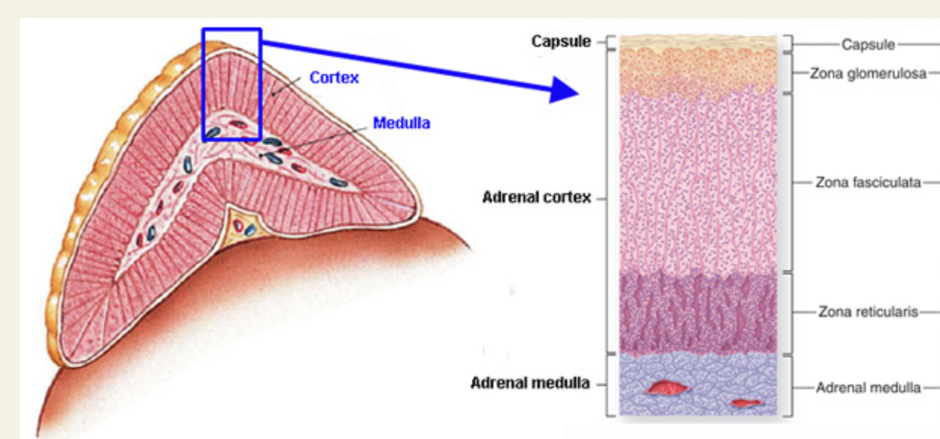U1vi / 19A06: Outline the physiology of the adrenal gland (70% of marks). Describe the actions of aldosterone (30% of marks).
19A06: Exam Report
Outline the physiology of the adrenal gland (70% of marks). Describe the actions of aldosterone (30% of marks).
43% of candidates passed this question.
Lack of breadth and detail were in many of the answers. Physiology of the adrenal gland includes an outline of the adrenal medulla, the types of chromaffin cells, hormones secreted and how secretion is stimulated. The three zones of the adrenal cortex should have been outlined including substances secreted, their function and again how their secretion is stimulated. The actions of aldosterone should have been described; a comment on sodium and water excretion was insufficient to attain many marks for this section. The extra-renal actions of aldosterone were missing from most answers.
U1vi / 19A06: Outline the physiology of the adrenal gland (70% of marks). Describe the actions of aldosterone (30% of marks).
Tips
Just have clear headings so you sign post for the examiners and don’t miss anything, it’s a big topic but can be neatly summarised if you have done it before
Definition
- The paired Adrenal glands are suprarenal endocrine glands
Overview
- Adrenal Medulla is the inner portion – glucocorticoid
- Adrenal Cortex is the outer portion – mineralcorticoid
- Like other glands that secrete hormones directly into the blood stream, the adrenals have a rich blood supply:
- Sup, Middle & Inf Suprarenal arteries (from the Phrenic Artery, Abdominal Aorta and Renal Artery respectively)
- Nervous supply is from the coeliac plexus and thoracic splachnic nerves to supply chromaffin cells


Adrenal Medulla
- Neuroendocrine tissue that contains chromaffins cells (phaechromocytes) which are surrounded by meshwork of sinusoids
- 3 types of chromaffin cells:
- A cells – stores adrenaline
- NA cells – noradrenaline storing
- small-granule chromaffin (SGC) cells, intermediate between NA + A
- This neuroendocrine tissue is considered a ‘post-ganglionic sympathetic neuron’ and extension of the ANS
- Innervated by sympathetic neurons of the thoracic spinal cord
- Stimulus for sympathetic activation: hypoxia, stress, hypoglycaemia, trauma, hyperthermia, exercise
- Pre-ganglionic sympathetic nerve endings release ACh
- ACh causes calcium-dependant exocytosis of cytoplasmic storage granules
- Releases of catecholamine hormones Noradrenaline & Adrenaline into sinusoids
- Regulation of catecholamine release is via negative feedback mechanisms involving NA which inhibits ACh release from pre-synaptic a2 receptors and also inhibits tyrosine hydroxylase activity when [NA] is high
Adrenal Cortex
Multi-layered lipid storing cells structured into 3 distinct regions:
- Zona Glomerulosa: outermost layer of adrenals
- Synthesises mineralocorticoids – most important is aldosterone
- The synthesis of aldosterone is triggered by:
- Increase in plasma concentration of Angiotensin II
- Increase in Plasma K+ concentration
- Decrease in plasma pH
- Decrease in blood pressure as detected by atrial stretch receptors
- Zona Fasciculata: makes up 50% of mass of gland
- Made up of parenchymal cells called spongiocytes
- Secrete glucocorticoids: cortisol and corticosterone
- These hormones regulate carbohydrate metabolism
- Glucocorticoids are synthesised from cholesterol
- Released in response to increase in ACTH from Anterior pituitary
- Zona Reticularis: innermost layer
- Biosynthesis of androgen precursors from cholesterol (these are converted to testosterone or oestrogen):
- DHEA (dehydroepiandrosterone)
- Androstenedione
- Responsible for development of sexual characteristics during puberty
- Production of androgens are regulated by ACTH
- Biosynthesis of androgen precursors from cholesterol (these are converted to testosterone or oestrogen):
Aldosterone
- The Primary Mineralcorticoid steroid hormone
- Synthesised from cholesterol
- No storage mechanism – produced & released on demand
- Diurnal secretion (70% is secreted between 0700-1000hrs)
- Stimulus for secretion:
- Increase in plasma concentration of Angiotensin II
- Increase in Plasma K+ concentration
- Increase ACTH (catalyses cholesterol to Pregnenolone)
- Decrease in plasma pH
- Decrease in blood pressure as detected by atrial stretch receptors
- Actions:
- Renal:
- Aldosterone interacts with the mineralocorticoid receptors in the late distal tubules and collecting duct
- Increases the expression of epithelial Na channels (ENAc) and increases absorption of sodium and excretion of potassium
- At Type A Intercalated cells promotes H+ loss in the urine by increasing the activity of H/K/ATPase which promotes K and Cl- reabsorption to maintain electroneutrality
- Extra-renal: it also has a similar action in the colon, increases sodium absorption from stool
- Renal:
Author: Ruvi Vithanage / Krisoula Zahariou